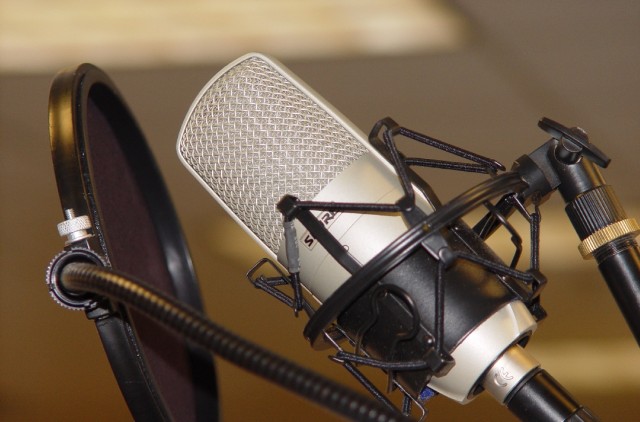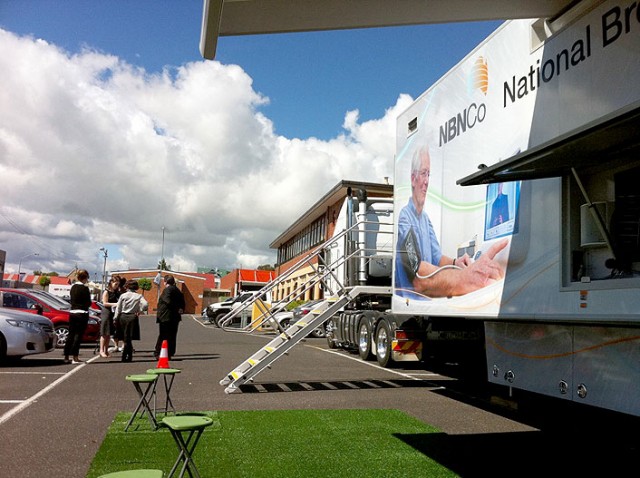For the February 2012 Nightlife technology spot Tony and Paul looked at Australia’s National Broadband Network, exploring the pros and cons of the project designed to connect all Australians to high speed broadband.
So what is the NBN and what does it do? Here’s some of the points we discussed along with some of the answers to listeners’ questions.
What is the NBN?
The National Broadband Network is intended replace the existing copper wire telephone network that was rolled out across the nation over the Twentieth century.
Eventually the network will provide fast data access across the country replacing the older network that was designed for telephone calls rather than computer communications.
Most of the country will be connected to fibre optic cables and areas where this is too expensive then wireless or satellite services will be used.
Why do we need a government run national network?
The NBN is the culmination of three decades of bad policy out of Canberra. We should remember that the Howard government struggled with how to provide high speed broadband access to the bush.
For coalition things became particularly bad once they privatised Telstra and no longer had any power over the company’s policies.
We’ve had a mix of ideological beliefs and rubbery figures from both sides of politics which have left Australia in the situation where the core telecoms network has had to be re-nationalised.
What are these different ways of connecting up?
The biggest part of the network will be fibre optic cable where the connection will run along the street like the existing telephone wires and will connect to a box outside your home or office.
This box – know as an NTD (Network Terminating Device) is then connected into either the existing household telephone system or into a computer network.
In areas receiving wireless and satellite subscribers will get dishes or receivers that plug into their existing home telephone or computer network.
There are different types of wireless
The different types of wireless networks cause confusion. The NBN is going to use 4G or LTE telephone wireless, which is what Telstra have started to roll out and Optus will be starting in the Hunter Valley around Easter 2012.
Most of us are using 3G networks on our phones which is what the bulk of the mobile phone networks are.
Another type of wireless is the Wireless Local Area Network. These are what we connect our home or office computers to. These plug into the existing services like the existing ADSL internet connections or the NBN’s fibre network.
We shouldn’t confuse Wireless LANs with the mobile phone technologies being used by the NBN or phone companies.
Who is running the NBN?
The organisation set up to build the NBN is NBNCo. They are setting the standards, negotiating access to existing infrastructure and building the network. Their head office is in North Sydney but major operations are also based in Melbourne.
In turn they are hiring contractors around the country to build the network, run the cables and connect buildings to the new services. Most of us will deal with those contractors and the companies selling NBNCo’s services.
How is National Broadband Network going to work?
We won’t talk to NBNCo directly, instead companies like Telstra, Optus, Vodafone and iiNet will buy services from them and then onsell them to us.
Telstra are playing an interesting game on competing. They are already offering 4G services in regional areas where NBNCo hasn’t announced rollouts and they are planning to upgrade their cable TV network to the DOCSIS 3.0 standard that can sometimes deliver speeds similar to the NBNs proposed service.
What happens if you don’t let them connect you
If you don’t let NBNCo’s contractors connect you to the new network then you’ll have a problem a year or so later.
The copper telephone network is going to be turned off in areas where fibre optic cables are installed so if you aren’t connected to the new system, you won’t have access.
Anyone who’s done some building or landscaping work knows it isn’t cheap and that’s what building owners who don’t allow access will have to pay for access later.
In Tasmania a few property owners who were just outside the NBN area asked about getting connected up and apparently the costs were prohibitive.
One of the things to watch out for is uncooperative building managers preventing NBN contractors from accessing their premises leaving all the residents disconnected when the phone network is turned off.
Will it really cost $14,000 to wire up your house?
No but there will be a cost to connect the building’s existing phone lines and power supply to the NBN’s Network Terminal Device (NTD) that will be bolted to the outside of the building.
The NTDs are designed to plug into existing phone systems and data networks so it shouldn’t be necessary to spend a fortune on connections or upgrades.
One area where there might be problems is in buildings that have substandard wiring. Licensed electricians and cablers will refuse to work on systems that don’t comply with standards so building owners may find they are faced with big bills to bring their systems up to standard.
Does the system work if the power goes out?
Yes, the basic cabling doesn’t need power, although the repeaters and local exchanges will – just like the phone network. Where the system does need power is at the NTDs which will come with a battery providing two to three hours power.
If the NBN gets hit by lightning, does it stop working?
Lightning is an incredibly powerful force. It doesn’t matter whether we’re talking about telephones, power or fibre optic networks – anything that is hit by lightning is going to be damaged.
We should keep in mind that the wireless alternative to fibre is more prone to lightening strikes as base stations are at high points.
Electrical storms, and other natural forces, are a fact of life that we have to work around. The existing systems are just as prone to interruptions.
Is it running behind schedule?
Yes, as of the beginning of 2012 the project seems to be about six months behind. With only 4,000 connections at the end of last year instead of the 30,000 expected by the middle of last year.
NBNCo are putting this down to delays in finalising negotiations with Telstra and other existing fibre providers.
How much is it really going to cost?
There’s still the $43 billion dollar number on the table, which comes from a KPMG study in 2010 although the government claims their investment is going to $27 billion.
Of that 27 billion, the government expects to recoup it by 2034 based on a 7% return.
In contrast the opposition are claiming the real cost is $50 billion as they are including the cost of buying Telstra’s infrastructure back.
The real number is anyone’s guess. The track record of both political parties and Canberra’s bureaucrats on estimating costs on projects like this is less than impressive.
Is it really worth the money?
We should keep in mind a lot of this money was going to be spent by Telstra or the other providers anyway over the next two decades as the copper telephone reached the end of its life.
The risk was we would see something like the cable TV rollout where the big players fought over the most lucrative parts of the country and ignored the rest. The NBN avoids that.
There are real concerns though as the NBN is running behind schedule, the procurement processes – particularly the construction contracts – appear to have been poorly handled and there has been little discussion about the technology options.
Overall though, this is an opportunity to get the 21st Century infrastructure right. Where Australia failed with the roads in the 20th Century and the trains in the 19th, we can get this one right.
Similar posts:


